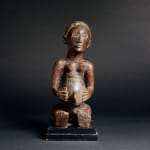Luba Figure of a Woman, 19th - 20th century
Wood
height 37 cm
height 14 5/8 in
height 14 5/8 in
MA.245
Further images
This sculpture is a beautiful example of a Luba figure. The scarification runs from the shoulders down to the belly as the figure sits holding a decorative vessel. Three metal...
This sculpture is a beautiful example of a Luba figure. The scarification runs from the shoulders down to the belly as the figure sits holding a decorative vessel. Three metal pins frame the face and draw attention to the stylised hair/headress.
The exact date of the founding of the Luba Kingdom is uncertain. According to oral tradition, the cultural hero Kalala Ilunga conquered the lands of adjacent chiefs along the Lualaba River. He and his successors were venerated as living divinities capable of great power. During the eighteenth century the Luba empire expanded eastward and southward until it reached the basins of the Sankuru and Lomami rivers. Luba art consequently varies regionally and has also influenced the art of neighboring peoples including the Hemba and the Boyo. Most of the Luba art in Western collections was originally produced in association with royal or chiefly courts and was meant to validate the power of leaders. Luba art forms tend to be delicately modeled and curvilinear, expressing serenity and introspection.
Among the characteristics of Luba sculpture are: intricate hair-dress, often in the form of a cross, or falling down like a cascade; a grooved diagonal band separating the hair-line from the forehead; eyes shaped like coffee-beans; small simplified ‘cat’s ears’; ornamental cicatrices in relief on the body; the surface elaborately worked and polished. The traditional carvings are for ancestor and spirit cults, for initiation, medical and divination purposes. The favorite theme in sculpture was woman since, according to the Luba myth, vilie was the first woman spirit, founder of the clan and guarantor of fertility and the lineage. Women were cult guardians, and the royal wives played an important role: sent as emissaries to the chiefs of neighboring ethnicities, they would contract profitable political alliances based on marriage. Some figures are freestanding, almost always in a frontal position, often with their hands on their breasts; others are kneeling, sitting, or standing figures whose upraised hands serve as supports for bowls, seats, and neck rests. The figures are often characterized by elaborate scarification patterns on the body. The diviner, painted white, used the mboko, a seated or crouched female figure holding a bowl robbed with kaolin. He would shake her and analyze the position of the different objects the bowl contained. In the healing ritual, the sorcerer would use the kabila, or daughter of the spirit, which consisted of a figure and receptacle, which were also placed at the entry to the house during the childbirth. The female figures are modeled in rounded forms and have what is called dodu; that is, a stylistic tendency toward plumpness. One well-known Luba sub-style has been called the "long-face style" of Buli. It contrasts strongly with the roundness of other Luba figures. The faces are elongated, with angular, elegant features. Many Luba statues also carry magic ingredients on the top of the head.
The exact date of the founding of the Luba Kingdom is uncertain. According to oral tradition, the cultural hero Kalala Ilunga conquered the lands of adjacent chiefs along the Lualaba River. He and his successors were venerated as living divinities capable of great power. During the eighteenth century the Luba empire expanded eastward and southward until it reached the basins of the Sankuru and Lomami rivers. Luba art consequently varies regionally and has also influenced the art of neighboring peoples including the Hemba and the Boyo. Most of the Luba art in Western collections was originally produced in association with royal or chiefly courts and was meant to validate the power of leaders. Luba art forms tend to be delicately modeled and curvilinear, expressing serenity and introspection.
Among the characteristics of Luba sculpture are: intricate hair-dress, often in the form of a cross, or falling down like a cascade; a grooved diagonal band separating the hair-line from the forehead; eyes shaped like coffee-beans; small simplified ‘cat’s ears’; ornamental cicatrices in relief on the body; the surface elaborately worked and polished. The traditional carvings are for ancestor and spirit cults, for initiation, medical and divination purposes. The favorite theme in sculpture was woman since, according to the Luba myth, vilie was the first woman spirit, founder of the clan and guarantor of fertility and the lineage. Women were cult guardians, and the royal wives played an important role: sent as emissaries to the chiefs of neighboring ethnicities, they would contract profitable political alliances based on marriage. Some figures are freestanding, almost always in a frontal position, often with their hands on their breasts; others are kneeling, sitting, or standing figures whose upraised hands serve as supports for bowls, seats, and neck rests. The figures are often characterized by elaborate scarification patterns on the body. The diviner, painted white, used the mboko, a seated or crouched female figure holding a bowl robbed with kaolin. He would shake her and analyze the position of the different objects the bowl contained. In the healing ritual, the sorcerer would use the kabila, or daughter of the spirit, which consisted of a figure and receptacle, which were also placed at the entry to the house during the childbirth. The female figures are modeled in rounded forms and have what is called dodu; that is, a stylistic tendency toward plumpness. One well-known Luba sub-style has been called the "long-face style" of Buli. It contrasts strongly with the roundness of other Luba figures. The faces are elongated, with angular, elegant features. Many Luba statues also carry magic ingredients on the top of the head.







